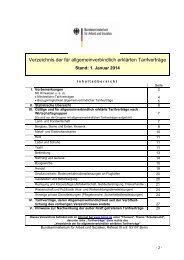Heads of PES concept for the delivery of the Youth Guarantee [PDF ...
Heads of PES concept for the delivery of the Youth Guarantee [PDF ...
Heads of PES concept for the delivery of the Youth Guarantee [PDF ...
You also want an ePaper? Increase the reach of your titles
YUMPU automatically turns print PDFs into web optimized ePapers that Google loves.
<strong>Heads</strong> <strong>of</strong> <strong>PES</strong> <strong>concept</strong> <strong>for</strong> <strong>the</strong> <strong>delivery</strong> <strong>of</strong> <strong>the</strong> <strong>Youth</strong> <strong>Guarantee</strong><br />
ABSTRACT<br />
This paper looks at medium-long-term institutional and organizational changes to contribute<br />
preventively to a better integration <strong>of</strong> young people into <strong>the</strong> labour market. It also presents <strong>the</strong><br />
short-term labour market measures that should back up long term re<strong>for</strong>ms.<br />
Concerning medium-long term changes action needs to be taken to facilitate transitions from<br />
education to work by interlinking classroom and workplace-related training components. Second,<br />
in order to make career decision on an in<strong>for</strong>med basis, <strong>the</strong> development <strong>of</strong> systematic<br />
vocational advisory structures is necessary. Eventually, Member States need to ensure <strong>the</strong><br />
effectiveness <strong>of</strong> <strong>the</strong>ir Public Employment Services (<strong>PES</strong>) in order to allow <strong>the</strong>m to make a<br />
crucial contribution to implementing a youth guarantee scheme. The document details <strong>the</strong><br />
main functions <strong>of</strong> <strong>PES</strong> – ranging from transparency measures, reach out measures to unregistered<br />
youth, counselling and placement services to per<strong>for</strong>mance measurement - and makes<br />
suggestions on how <strong>the</strong>y can most effectively fulfil <strong>the</strong>m. It is essential <strong>for</strong> <strong>the</strong> successful implementation<br />
<strong>of</strong> <strong>the</strong> <strong>Youth</strong> <strong>Guarantee</strong> that <strong>PES</strong> have pr<strong>of</strong>ound knowledge about <strong>the</strong> structure<br />
<strong>of</strong> youth unemployment, <strong>the</strong> strengths and weaknesses <strong>of</strong> young people and on job opportunities<br />
including specific job requirements.<br />
Fur<strong>the</strong>rmore <strong>the</strong> text outlines some basic success criteria <strong>of</strong> labour market policy measures<br />
that have proved <strong>the</strong>ir value under various framework conditions. These criteria are simplicity,<br />
transparency <strong>for</strong> people not yet registered, accuracy to fit, measurability and reversibility.<br />
The <strong>concept</strong> describes as well examples <strong>of</strong> labour market policy measures that will support<br />
long term development, such as active labour market policies or measures <strong>for</strong> improving qualifications.<br />
In supplement to <strong>the</strong>se measures to be implemented on <strong>the</strong> home market, supporting mobility<br />
within Europe through <strong>the</strong> EURES network is a key lever <strong>for</strong> reducing youth unemployment.<br />
It is as well crucial to learn from good practices <strong>of</strong> o<strong>the</strong>r Member States/<strong>PES</strong> as it has already<br />
been done in <strong>the</strong> frame <strong>of</strong> <strong>the</strong> <strong>PES</strong> network.<br />
1
<strong>Heads</strong> <strong>of</strong> <strong>PES</strong> <strong>concept</strong> <strong>for</strong> <strong>the</strong> <strong>delivery</strong> <strong>of</strong> <strong>the</strong> <strong>Youth</strong> <strong>Guarantee</strong><br />
1 Starting point and objective<br />
With <strong>the</strong> recommendation on <strong>the</strong> EU ‘<strong>Youth</strong> <strong>Guarantee</strong>’ scheme a framework was created in<br />
which Member States can take measures adjusted to <strong>the</strong> respective constitution <strong>of</strong> <strong>the</strong>ir employment<br />
market to combat <strong>the</strong> high level <strong>of</strong> youth unemployment. These measures are intended<br />
in principle to bring young people back into (high-grade) employment or training as<br />
quickly as possible after <strong>the</strong>y leave school or complete training, or lose <strong>the</strong>ir jobs. The Commission<br />
recommends that public employment services (<strong>PES</strong>) use a mix <strong>of</strong> counselling, activation,<br />
training and placements, based on meticulous regional analyses.<br />
The experiences <strong>of</strong> many Member States can be used with regard to <strong>the</strong> question <strong>of</strong> which<br />
measures from this canon are suitable <strong>for</strong> achieving <strong>the</strong> ambitious goals, experiences that<br />
include coping with <strong>the</strong>ir own labour market crises (<strong>for</strong> example mastering structural change<br />
in mining areas). The following summary provides an overview <strong>of</strong> <strong>the</strong> experiences and <strong>the</strong><br />
recommendations that result from <strong>the</strong>m.<br />
In <strong>the</strong> process, institutional-organisational changes will be proposed, such as a reorientation<br />
<strong>of</strong> <strong>the</strong> education system towards improved interlinking <strong>of</strong> classroom and company components,<br />
or measures <strong>for</strong> increasing <strong>the</strong> per<strong>for</strong>mance <strong>of</strong> <strong>the</strong> <strong>PES</strong>. These measures can contribute<br />
preventively to better integration <strong>of</strong> young people into <strong>the</strong> labour market, but only develop<br />
<strong>the</strong>ir impact in <strong>the</strong> medium- to long-term. For this reason, additional labour market policy instruments<br />
are recommended that, where used properly, contribute in <strong>the</strong> short term at least<br />
to alleviating labour market problems, and in <strong>the</strong> medium term can serve as back-up<br />
measures <strong>for</strong> low achieving young people.<br />
In <strong>the</strong> design <strong>of</strong> <strong>the</strong> measures and <strong>the</strong> question <strong>of</strong> which (bundles <strong>of</strong>) measures are practical,<br />
it is not merely a matter <strong>of</strong> direct integration into employment, it is also, <strong>for</strong> example, about<br />
facilitating <strong>the</strong> transition from school to work, or increasing <strong>the</strong> proportion <strong>of</strong> those with vocational<br />
qualifications. In <strong>the</strong> course <strong>of</strong> this, <strong>the</strong> recommendations below take into account in<br />
particular <strong>the</strong> fact that <strong>the</strong> causes <strong>of</strong> high youth unemployment differ from country to country<br />
in <strong>the</strong> EU. In some countries, <strong>the</strong> major problem is in <strong>the</strong> great numbers <strong>of</strong> people who leave<br />
<strong>the</strong> education system without a useful qualification; in o<strong>the</strong>rs, <strong>the</strong> main cause is that <strong>the</strong> labour<br />
market is closed <strong>of</strong>f to new entrants as a secondary effect <strong>of</strong> statutory or collective<br />
wage agreement provisions, or <strong>the</strong> lack <strong>of</strong> sustainability <strong>of</strong> new employment relationships <strong>for</strong><br />
young people because <strong>of</strong> <strong>the</strong> high proportion <strong>of</strong> short-term contracts.<br />
2
2 Initiating institutional changes and realising <strong>the</strong>m successfully<br />
2.1 Overview over possible institutional changes to combat youth employment<br />
The following table gives an overview over possible institutional changes that have proven to<br />
be useful in fostering youth employment in a bunch <strong>of</strong> Member states. In <strong>the</strong> sections below<br />
<strong>the</strong> measures are described in more detail.<br />
Table 1: Institutional changes to combat youth unemployment: Overview over measures, target<br />
groups and time frame<br />
Main obstacle<br />
Insufficient<br />
knowledge about<br />
<strong>the</strong> overall structure<br />
and nature <strong>of</strong> <strong>the</strong><br />
national labour market<br />
Insufficient matching<br />
capacity <strong>of</strong> geographically<br />
separated<br />
supply and demand<br />
Insufficient<br />
knowledge <strong>of</strong> <strong>the</strong><br />
aggregated macroeconomic<br />
demand<br />
<strong>for</strong> labour<br />
Lack <strong>of</strong> knowledge<br />
about <strong>the</strong> group <strong>of</strong><br />
young unemployed<br />
or school leavers<br />
Insufficient<br />
knowledge among<br />
young people about<br />
<strong>the</strong> real economic<br />
and labour market<br />
situation (current<br />
opportunities, caveats,<br />
potential developments)<br />
*Time frame:<br />
Recommended<br />
measure<br />
Introduction <strong>of</strong> a<br />
national Labour<br />
Market Monitor <strong>for</strong> a<br />
systematic dialogue<br />
among stakeholders<br />
Introduce a national<br />
virtual labour market<br />
or increase <strong>the</strong> quality<br />
<strong>of</strong> <strong>the</strong> existing one<br />
Increase <strong>the</strong> market<br />
share <strong>of</strong> <strong>PES</strong> e.g.<br />
through an Employers<br />
Service<br />
Mandatory registration<br />
<strong>of</strong> vacancies<br />
Increase attractiveness<br />
<strong>of</strong> <strong>PES</strong> to become<br />
<strong>the</strong> single<br />
point <strong>of</strong> registration<br />
<strong>for</strong> young people<br />
Increase <strong>the</strong> outreach<br />
capacity <strong>of</strong><br />
<strong>PES</strong><br />
Increase guidance<br />
capacity<br />
Target group Time frame * Remarks<br />
Overall<br />
Overall<br />
Employers<br />
Employers<br />
Young people<br />
leaving school or<br />
becoming unemployed<br />
Young people after<br />
leaving school and<br />
those not receiving<br />
benefits<br />
Young people in<br />
school<br />
Short term<br />
Short term<br />
Medium term<br />
Short term<br />
Medium Term<br />
Short term<br />
Medium term<br />
Service <strong>of</strong>fer<br />
also <strong>for</strong> those<br />
not receiving<br />
benefits<br />
short term: can be implemented immediately<br />
medium term: minor preparations needed, can be implemented within one year<br />
long term: major preparations needed, can be implemented within three years<br />
3
2.2 Achieving interlinking <strong>of</strong> classroom and workplace-related training components<br />
In has been generally seen that good interlinking <strong>of</strong> classroom and company training components<br />
is an effective means <strong>of</strong> facilitating transition from <strong>the</strong> education system to <strong>the</strong> labour<br />
market. For this reason, we recommend that all Member States orient <strong>the</strong>ir education systems<br />
to this duality in <strong>the</strong> long term.<br />
The ef<strong>for</strong>ts that many Member States are already making here will be particularly successful<br />
if <strong>the</strong>y succeed in gaining <strong>the</strong> acceptance <strong>of</strong> companies <strong>for</strong> this <strong>concept</strong>, and attracting as<br />
many <strong>of</strong> <strong>the</strong>m as possible <strong>for</strong> <strong>the</strong> provision <strong>of</strong> suitable training places. The following success<br />
factors appear to be worth noting <strong>for</strong> this:<br />
<br />
<br />
<br />
<br />
<br />
<br />
<br />
Realisation must be adapted to <strong>the</strong> respective industrial constitution <strong>of</strong> <strong>the</strong> region. This<br />
means in particular that suitable <strong>concept</strong>s have to be applied that meet <strong>the</strong> needs <strong>of</strong> a<br />
mainly small-company structure. It can be an advantage here, <strong>for</strong> example, to anchor regional<br />
sector-based training combines, in which small companies can each take over a<br />
section <strong>of</strong> <strong>the</strong> vocational training.<br />
Back-up through counselling employers be<strong>for</strong>e and during <strong>the</strong> phases <strong>of</strong> in-company vocation<br />
training relieves <strong>the</strong> strain on companies and increases willingness to <strong>of</strong>fer training<br />
components.<br />
In <strong>the</strong> <strong>concept</strong>ion phase it is important that educational institutions and industry and trade<br />
associations work closely toge<strong>the</strong>r to achieve a practical coordination <strong>of</strong> school and incompany<br />
training components.<br />
Close integration <strong>of</strong> social partners in this process contributes to broad societal acceptance<br />
<strong>for</strong> <strong>the</strong> realignment <strong>of</strong> <strong>the</strong> training system.<br />
As nucleus <strong>for</strong> <strong>the</strong> process, and in order to be able to present good examples in <strong>the</strong> near<br />
term, cooperation with (internationally active) SMEs and larger companies can be used<br />
that already have experience with dual training systems in <strong>the</strong>ir countries <strong>of</strong> origin and<br />
are prepared to realise <strong>the</strong>se in <strong>the</strong> “host country”. Concluding regional cooperation<br />
agreements between educational institutions and employers can be useful here.<br />
Back-up in<strong>for</strong>mation and marketing campaigns can be useful <strong>for</strong> making people aware <strong>of</strong><br />
<strong>the</strong> advantages <strong>of</strong> dual vocational training and establishing it as a model not only <strong>for</strong> low<br />
achieving young people. An important component here is conversion into an advantage<br />
<strong>for</strong> employers. People from public life, <strong>for</strong> example, could be used here as ambassadors.<br />
A societal consensus has to be created in which employers and employees concur that<br />
investments in dual vocational training are worthwhile, not least because later on this<br />
training qualification is understood as a quality sign that is accepted everywhere.<br />
4
2.3 Developing nationwide vocational counselling structures<br />
In order <strong>for</strong> <strong>the</strong> dual vocational training system to be successful it is necessary that <strong>the</strong><br />
greatest possible number <strong>of</strong> young people leaving general education are in<strong>for</strong>med <strong>of</strong> its opportunities,<br />
and are thus able to make a career decision choice on an in<strong>for</strong>med basis. It<br />
<strong>the</strong>re<strong>for</strong>e requires, in addition, <strong>the</strong> development <strong>of</strong> systematic vocational advisory structures<br />
that begin at an early stage. The following components have proved to be valuable in this<br />
context:<br />
<br />
<br />
<br />
<br />
<br />
Nationwide events on careers in<strong>for</strong>mation and orientation in <strong>the</strong> final years <strong>of</strong> general<br />
education, which also closely integrate <strong>the</strong> employers, ensure that (nearly) all young<br />
people are reached and receive a set <strong>of</strong> basic in<strong>for</strong>mation.<br />
Augmenting face-to-face discussions with trained careers advisers can be <strong>of</strong>fered on <strong>the</strong><br />
basis <strong>of</strong> initial in<strong>for</strong>mation. Important competences <strong>of</strong> <strong>the</strong>se careers advisers are not only<br />
exact knowledge <strong>of</strong> <strong>the</strong> various job descriptions, vocational training paths, training contents<br />
and institutions, but also knowledge <strong>of</strong> <strong>the</strong> chances on <strong>the</strong> labour market <strong>of</strong> <strong>the</strong> vocational<br />
training chosen in each case.<br />
Along with advising direct users (that is, students, and/or <strong>the</strong>ir parents), services <strong>of</strong>fered<br />
by vocational advisory institutions should also include qualified advice <strong>for</strong> multipliers,<br />
such as teachers.<br />
The benefit <strong>of</strong> <strong>the</strong>se structures is increased if, where required, young people can be given<br />
placement <strong>of</strong>fers during <strong>the</strong>se advisory discussions. This necessitates close interlocking<br />
with <strong>the</strong> services <strong>of</strong> public employment market service providers, or even institutional<br />
integration <strong>of</strong> vocation guidance in <strong>the</strong> latter.<br />
Additional careers in<strong>for</strong>mation should be made available in online support that can be<br />
used as a basis to make an in<strong>for</strong>med decision on <strong>the</strong> choice <strong>of</strong> a career.<br />
2.4 Ensuring <strong>the</strong> effectiveness <strong>of</strong> public employment services<br />
2.4.1 Functions <strong>of</strong> public employment services<br />
Along with functioning vocational advisory structures, <strong>the</strong> second institutional element that<br />
can make a significant contribution to fulfilling <strong>the</strong> youth guarantee is functioning public employment<br />
services (<strong>PES</strong>) that discharge <strong>the</strong> following five functions (at least):<br />
<br />
<br />
<br />
<br />
<br />
Creation <strong>of</strong> transparency regarding supply and demand in <strong>the</strong> labour market and <strong>the</strong><br />
determinants <strong>for</strong> unemployment, including nationally<br />
Securing a high coverage <strong>of</strong> <strong>the</strong> youth guarantee<br />
Nationwide counselling services (personal or online) resulting from this on labour<br />
market questions <strong>for</strong> employees and employers<br />
Effective placement in employment or vocational training resulting from this<br />
Effective allocation <strong>of</strong> labour market policy measures as efficiently as possible.<br />
Creation <strong>of</strong> transparency regarding supply and demand in <strong>the</strong> labour market, including nationally<br />
In order to create transparency on <strong>the</strong> labour market - with regard to <strong>the</strong> target group <strong>of</strong> <strong>the</strong><br />
youth guarantee scheme – and to be able to analyse <strong>the</strong> respective determinants <strong>for</strong> youth<br />
5
unemployment, <strong>the</strong> first thing that is required – as already indicated above – is <strong>the</strong> broadest<br />
possible approach by careers advisers at an early stage, and <strong>the</strong> close interlinking <strong>of</strong> <strong>the</strong>se<br />
activities, including transmission <strong>of</strong> data collected <strong>the</strong>re to public employment services.<br />
Transparency with regard to employment and vocational training vacancies has to be created<br />
on <strong>the</strong> employer side as well:<br />
<br />
<br />
A specialised approach to employers, perhaps by dedicated contact partners in <strong>the</strong> <strong>PES</strong>,<br />
appears to be expedient here.<br />
Vacancies should be made available in a database that can be accessed nationally.<br />
Editing in a special tool lends itself as a method <strong>of</strong> making <strong>the</strong> acquired in<strong>for</strong>mation and <strong>the</strong><br />
consequences to be drawn from it available and usable simply <strong>for</strong> political decisions, but also<br />
to facilitate learning between regions.<br />
Securing a high coverage <strong>of</strong> <strong>the</strong> youth guarantee<br />
The following measures have proved to be successful with regard to secure a high coverage<br />
<strong>of</strong> <strong>the</strong> youth guarantee, especially through <strong>the</strong> creation <strong>of</strong> transparency on <strong>the</strong> applicant side:<br />
<br />
<br />
<br />
Outreach work and counselling in youth centres and similar institutions by counsellors<br />
from public employment services, where applicable coupled with young people acting as<br />
"ambassadors" and a snowball system. Partnerships with local authorities as well as<br />
NGOs have also proved to be effective in some countries.<br />
Incentives <strong>for</strong> young people to register with <strong>PES</strong> are increased, if not only placement and<br />
counselling services are <strong>of</strong>fered <strong>the</strong>re but also unemployment or social benefits are to be<br />
applied <strong>for</strong>.<br />
Back-up is advised through PR campaigns that publicise <strong>the</strong> advantages <strong>of</strong> registering<br />
with <strong>the</strong> <strong>PES</strong> (participation in <strong>the</strong> services <strong>of</strong> <strong>the</strong> youth guarantee scheme).<br />
Nationwide counselling services (personal or online) on labour market questions <strong>for</strong> employees<br />
and employers<br />
Services <strong>of</strong>fered by <strong>PES</strong> will only be used on a long-term basis if access to <strong>the</strong>m is possible<br />
everywhere and without complications. This is why it is important to make nationwide counselling<br />
services available and to implement standards that are as similar as possible.<br />
<br />
<br />
<br />
A multichannel strategy presents itself here in which in<strong>for</strong>mation and simple advisory<br />
matters can be processed online or by phone, while personal counselling interviews can<br />
take place <strong>for</strong> more complex matters.<br />
Access to counselling services should be open equally to benefits recipients and persons<br />
who are not entitled to transfer payments.<br />
If needed to enhance <strong>the</strong> counselling and/or placement capacities (temporarily or permanently),<br />
parts <strong>of</strong> <strong>the</strong> service can be contracted out to private providers.<br />
Effective placement in employment or vocational training<br />
The core <strong>of</strong> <strong>the</strong> activities <strong>PES</strong> is placement in employment or vocational training. The basic<br />
prerequisite <strong>for</strong> successful work with a great range is transparency <strong>of</strong> both sides <strong>of</strong> <strong>the</strong> market<br />
described above. On this basis, <strong>the</strong> following components <strong>of</strong> <strong>the</strong> work <strong>of</strong> <strong>PES</strong> have<br />
proved to be promising:<br />
6
Activities should start at an early stage, where possible be<strong>for</strong>e conclusion <strong>of</strong> vocational<br />
training or <strong>the</strong> start <strong>of</strong> unemployment.<br />
The basis is systematic, individual pr<strong>of</strong>iling that, along with <strong>for</strong>mal qualifications, reveals<br />
existing non-certified competences and a given need <strong>for</strong> action.<br />
An individual action plan is to be developed from this that is agreed between <strong>the</strong> young<br />
person and <strong>the</strong> placement <strong>of</strong>ficer and contains job-seeking and support activities <strong>of</strong> both<br />
sides.<br />
Pr<strong>of</strong>iling can be systematised and partly standardised with computer support. This contributes<br />
to <strong>the</strong> production <strong>of</strong> comparable applicant pr<strong>of</strong>iles that can be used, e.g., <strong>for</strong> automated<br />
matching. However, leaving <strong>the</strong> decision on <strong>the</strong> right action strategy – e.g. assignment<br />
to in a qualifying measure – with <strong>the</strong> placement <strong>of</strong>ficer, and not automating it,<br />
has proved to be successful.<br />
Making use <strong>of</strong> computer support on <strong>the</strong> vacancies side also lends itself. Employment and<br />
vocational training vacancies should be made available on a nationwide basis. Automated,<br />
and nationwide, matching increases <strong>the</strong> chance <strong>of</strong> exactly fitting placements and contributes<br />
to nationwide labour market adjustment.<br />
Effective Allocation <strong>of</strong> labour market policy measures<br />
An exactly fitting, high quality range <strong>of</strong> measures has to be ensured <strong>for</strong> those young persons<br />
who are unable to transfer directly to employment or vocational training. Which portfolio <strong>of</strong><br />
measures (quantitative and qualitative) is <strong>of</strong>fered in general is determined initially by <strong>the</strong> prevailing<br />
determinants <strong>of</strong> youth unemployment in each case – e.g. more qualification problems,<br />
or barriers to entry. The choice <strong>of</strong> <strong>the</strong> individually matched measure is <strong>the</strong>n supported by <strong>the</strong><br />
meticulous pr<strong>of</strong>iling described above, high-quality labour market advisory services building<br />
on this with an individual plan <strong>of</strong> action. In this process, <strong>the</strong> following aspects <strong>of</strong> quality assurance<br />
and measures purchasing are recommended:<br />
<br />
<br />
<br />
<br />
The public employment service should act in this respect at least as <strong>the</strong> agency that organises<br />
and tracks <strong>the</strong> provision <strong>of</strong> measures and <strong>the</strong>ir quality assurance.<br />
Which measures are carried out by <strong>the</strong> <strong>PES</strong> itself, and which are purchased from providers<br />
(make-or-buy decision), depends on <strong>the</strong> depth <strong>of</strong> services chosen in each case. It<br />
should always be considered which type <strong>of</strong> service provision is suitable with regard to<br />
quality, effect and economic efficiency.<br />
If a decision is taken to have a specific measure carried out by providers, this can be<br />
done ei<strong>the</strong>r through <strong>the</strong> direct purchase <strong>of</strong> places or by issuing vouchers with which<br />
young people can choose a measures provider <strong>the</strong>mselves. The latter increases competition<br />
and <strong>the</strong> self-reliance <strong>of</strong> young people, but can lead to <strong>the</strong>m being overtaxed. In addition,<br />
voucher solutions frequently fall down in sparsely populated regions in that appropriate<br />
measures do not materialise because <strong>of</strong> a lack <strong>of</strong> participants.<br />
Finally, quality assurance is decisive <strong>for</strong> <strong>the</strong> sensible appropriation <strong>of</strong> funds and an increase<br />
in <strong>the</strong> integration chance <strong>of</strong> participants. An independent quality assurance system<br />
with clear criteria should be implemented at an early stage here.<br />
7
2.4.2 Structural aspects<br />
Governance<br />
The way in which <strong>the</strong> governance <strong>of</strong> public employment market service providers should be<br />
structured depends greatly on <strong>the</strong> respective national situation. One question that has to be<br />
answered in all contexts is that <strong>of</strong> <strong>the</strong> right balance between central and local elements. In<br />
general, it has been seen that local scope <strong>for</strong> action is necessary: this enables an adjustment<br />
<strong>of</strong> labour market policy action to regional situations that is necessary because <strong>of</strong> major regional<br />
differences. In addition, it makes it possible in <strong>the</strong> first place <strong>for</strong> <strong>the</strong> <strong>PES</strong> to act as a<br />
constructive partner <strong>for</strong> regional economic and labour market development.<br />
On <strong>the</strong> o<strong>the</strong>r hand, a modicum <strong>of</strong> central control is important in order to be able to implement<br />
uni<strong>for</strong>m quality standards and to coordinate regional activities to a national strategy by<br />
means <strong>of</strong> target agreements and target maintenance. Apart from this, certain functions <strong>of</strong> <strong>the</strong><br />
<strong>PES</strong>, such as <strong>the</strong> transparency function described above, are best carried out centrally.<br />
Finally, <strong>the</strong> inclusion <strong>of</strong> social partners in <strong>the</strong> governance <strong>of</strong> <strong>the</strong> <strong>PES</strong> – at least on an advisory<br />
basis – has proved to be a practical element <strong>for</strong> creating <strong>the</strong> broadest possible societal<br />
consensus regarding labour market policy activities.<br />
Measuring success and monitoring<br />
Effective monitoring <strong>of</strong> <strong>the</strong> services <strong>of</strong>fered and <strong>the</strong>ir success is necessary in order to enable<br />
systematic fur<strong>the</strong>r development <strong>of</strong> <strong>the</strong> range <strong>of</strong> services and <strong>the</strong> catalogue <strong>of</strong> measures. This<br />
means that investments must be made in systematic data collection and processing.<br />
In <strong>the</strong> context <strong>of</strong> <strong>the</strong> youth guarantee scheme, it appears here to be necessary as a minimum<br />
to describe <strong>the</strong> category <strong>of</strong> persons affected sufficiently differentiated with regard to <strong>the</strong>ir<br />
characteristics, and on this basis to be able to <strong>for</strong>m meaningful rough indicators on <strong>the</strong> start<br />
<strong>of</strong> measures <strong>for</strong> <strong>the</strong> purposes <strong>of</strong> <strong>the</strong> scheme, on acquiring qualifications, on <strong>the</strong> transfer to<br />
employment and on <strong>the</strong> sustainability <strong>of</strong> <strong>the</strong> employment relationships that are created. It<br />
should be possible to differentiate <strong>the</strong>se indicators regionally and in accordance with <strong>the</strong><br />
most important socio-demographic dimensions.<br />
3 Organising back-up through labour market policy measures<br />
Back-up labour market policy measures <strong>for</strong> <strong>the</strong> short-term improvement <strong>of</strong> <strong>the</strong> regional employment<br />
situation are necessary <strong>for</strong> <strong>the</strong> transitional process, until <strong>the</strong> measures sketched<br />
above have developed <strong>the</strong>ir full impact. Even after <strong>the</strong> establishment <strong>of</strong> an effective system<br />
<strong>of</strong> education in close cooperation with companies and appropriate counselling structures,<br />
and on an improvement <strong>of</strong> <strong>the</strong> economic situation, <strong>the</strong> measures described below <strong>for</strong> academically<br />
weak young people are practical and should <strong>the</strong>re<strong>for</strong>e be kept in <strong>the</strong> portfolio <strong>of</strong><br />
public employment market service providers. For this reason it is useful to choose <strong>the</strong><br />
measures to be taken now so that <strong>the</strong>y support long-term developments structural change<br />
and more duality in <strong>the</strong> vocational training system and do not hinder <strong>the</strong>m.<br />
8
However, in <strong>the</strong> process, expectations regarding <strong>the</strong> extent to which youth unemployment<br />
can be reduced by labour market policy measures in <strong>the</strong> short run should not be raised too<br />
high. Even if several measures types are used in combination, labour market policies in<br />
times <strong>of</strong> an economic crisis with weak demand <strong>for</strong> labour can make only a minor contribution<br />
to labour market adjustment.<br />
3.1 What makes successful measures<br />
The success <strong>of</strong> a labour market policy measure is assessed on whe<strong>the</strong>r <strong>the</strong> expected effects<br />
with it can be achieved within an acceptable period <strong>of</strong> time and with acceptable use <strong>of</strong> resources.<br />
In <strong>the</strong> context described here, expected effects can refer above all to <strong>the</strong> improvement<br />
in <strong>the</strong> chances <strong>of</strong> integration and to a measurable acquisition <strong>of</strong> qualifications. However,<br />
<strong>the</strong>re are also additional effects, such as an improvement to <strong>the</strong> employment or qualifications<br />
structure, facilitating participation in society, or <strong>the</strong> gradual dismantling <strong>of</strong> labour market<br />
barriers. How <strong>the</strong> respective targets are weighted depends in <strong>the</strong> end on <strong>the</strong> regional context<br />
and is to be decided in <strong>the</strong> political process. Accordingly, which measure is successful and<br />
which is not cannot be decided in advance independently <strong>of</strong> <strong>the</strong> regional context. However,<br />
some basic criteria can be described that have proved <strong>the</strong>ir value in various framework conditions:<br />
<br />
<br />
<br />
<br />
<br />
Simplicity: <strong>the</strong> simpler a measure is structured – <strong>for</strong> example, with regard to access conditions<br />
and paths – <strong>the</strong> higher its acceptance will be.<br />
Transparency: closely connected to this is <strong>the</strong> requirement that in<strong>for</strong>mation on existing<br />
measures is also available <strong>for</strong> persons who have not (yet) registered with <strong>the</strong> employment<br />
service. This generates an incentive effect <strong>for</strong> registrations and increases <strong>the</strong> range<br />
<strong>of</strong> <strong>the</strong> youth guarantee scheme.<br />
Accuracy <strong>of</strong> fit: measures must be tailored to individual needs <strong>for</strong> action and match <strong>the</strong><br />
regional setting. There is no standard measure that is effective <strong>for</strong> all on a large scale.<br />
Measurability: measures should be set up so that <strong>the</strong>ir success can be measured. This<br />
includes defining <strong>the</strong> expected effect clearly be<strong>for</strong>ehand.<br />
Reversibility: a clear “best by date” should be included, above all when measures are<br />
implemented in labour market crisis situations, so that parallel structures are not created<br />
and threatening suppression effects are to be limited (particularly important with direct<br />
employment promotion).<br />
In principle, depending on <strong>the</strong> prevailing framework conditions and problem situation in a<br />
Member State, <strong>the</strong>re are three possible groups <strong>of</strong> measures <strong>for</strong> use in <strong>the</strong> framework <strong>of</strong> <strong>the</strong><br />
youth guarantee scheme, which can (and must) also be used in combination. These are<br />
measures <strong>for</strong> acquiring qualifications, those <strong>for</strong> facilitating entry to <strong>the</strong> labour market and<br />
employment measures. Individual measures and possible success factors will be discussed<br />
in more detail below.<br />
9
3.2 Step by step: How to allocate labour market policy measures<br />
Precondition <strong>for</strong> <strong>the</strong> allocation <strong>of</strong> all kinds <strong>of</strong> ALMP measures:<br />
1. Get transparency over <strong>the</strong> (regional) structure <strong>of</strong> potential participants and <strong>the</strong>ir main<br />
obstacles in finding employment<br />
Sources (examples):<br />
those registered with <strong>the</strong> <strong>PES</strong><br />
outreach activities<br />
media campaigns<br />
Example: Allocation <strong>of</strong> qualification measures<br />
2. Get transparency over <strong>the</strong> regional demands <strong>for</strong> skilled workers, especially regarding<br />
branches<br />
required skills and qualifications<br />
quantities<br />
3. Get regional transparency over <strong>the</strong> providers <strong>of</strong> <strong>the</strong> required qualification measures<br />
4. Draw up a regional qualification measures’ scheme describing contents, condition and<br />
quantity <strong>of</strong> each measure. Involve regional partners:<br />
employers’ organisations<br />
social partners<br />
local chambers<br />
training providers<br />
5. Decide about <strong>the</strong> allocation mechanism:<br />
direct purchase <strong>of</strong> places<br />
issuing vouchers<br />
both<br />
6. For each potential participant, carry out a meticulous pr<strong>of</strong>iling, containing<br />
skills and qualifications ad hand<br />
career aspiration<br />
promoting and detaining frame conditions<br />
obstacles regarding employment<br />
10
3.3 Overview over active labour market policy measures to fight youth unemployment<br />
In <strong>the</strong> following table, an overview over ALMP measures is presented which have proven to<br />
be useful in different institutional context, as evaluation studies show. In <strong>the</strong> sections below<br />
<strong>the</strong> measures again are described in more detail.<br />
Table 2: Active labour market policy to combat youth unemployment: Overview over conditions,<br />
time frame and expected quantitative impact<br />
Main reason <strong>for</strong><br />
high youth unemployment<br />
High proportion<br />
<strong>of</strong> school leavers<br />
without degree<br />
High proportion<br />
<strong>of</strong> youth without<br />
vocational qualification<br />
Problems in<br />
entering <strong>the</strong><br />
labour market<br />
Low economic<br />
dynamics<br />
Low economic<br />
dynamics plus<br />
lacks in regional<br />
infrastructure<br />
Recommended<br />
measure<br />
Promotion <strong>of</strong><br />
measures to<br />
catch up on<br />
school degrees<br />
Promotion <strong>of</strong><br />
measures <strong>of</strong><br />
vocational training<br />
Wage subsidies<br />
to employers<br />
Internships<br />
Credits with better<br />
conditions to<br />
employers giving<br />
a job to young<br />
people<br />
Promotion <strong>of</strong><br />
entrepreneurship<br />
Public employment<br />
projects<br />
Target group Time frame * Quantitative<br />
impact**<br />
Young school<br />
leavers without<br />
degree<br />
Young people<br />
without vocational<br />
qualification<br />
Qualified<br />
young people<br />
at <strong>the</strong> beginning<br />
<strong>of</strong> career<br />
Qualified<br />
young people<br />
without work<br />
experience<br />
Qualified<br />
young people<br />
at <strong>the</strong> beginning<br />
<strong>of</strong> career<br />
Qualified<br />
young adults<br />
with first work<br />
experience<br />
Low achieving<br />
young unemployed<br />
Remarks<br />
medium term High Close cooperation<br />
among<br />
local players<br />
needed<br />
medium term High Connection <strong>of</strong><br />
classroom and<br />
workplacerelated<br />
training<br />
needed<br />
short term medium Rules <strong>for</strong><br />
amount and<br />
duration <strong>of</strong> subsidy<br />
needed to<br />
reduce dead<br />
weight effects<br />
short term High Duration dependent<br />
on<br />
work experience<br />
at hand to<br />
reduce dead<br />
weight effects<br />
short term medium Focus on small<br />
enterprises<br />
medium term medium Parallel coaching<br />
and counselling<br />
activities<br />
improve sustainability<br />
short term Low Temporary projects<br />
with local<br />
approach only<br />
<strong>for</strong> low achieving<br />
- o<strong>the</strong>rwise<br />
high risk <strong>of</strong><br />
crowding out<br />
* Time frame: short term: can be implemented immediately<br />
medium term: minor preparations needed, can be implemented within one year<br />
long term: major preparations needed, can be implemented within three years<br />
** Quantitative impact:<br />
high: <strong>for</strong> all members/a large fraction <strong>of</strong> <strong>the</strong> target group, not limited to certain regions<br />
medium: <strong>for</strong> a fraction <strong>of</strong> <strong>the</strong> target group, or only <strong>for</strong> certain regions<br />
low: only <strong>for</strong> a small fraction <strong>of</strong> <strong>the</strong> target group, and/or <strong>for</strong> certain regions<br />
11
3.4 Measures <strong>for</strong> improving qualifications<br />
Measures <strong>for</strong> improving qualifications must be always be differentiated between those aimed<br />
at catching up on school-leaving certificates, and those that facilitate vocational qualifications.<br />
3.4.1 Measures aimed at catching up on school-leaving certificates<br />
<br />
<br />
<br />
Framework conditions under which <strong>the</strong>se measures make sense<br />
<br />
Regions with high proportions <strong>of</strong> school leavers without a general leaving certificate<br />
Target group<br />
<br />
Young persons without school-leaving certificates<br />
Success factors<br />
<br />
To ensure that addressing <strong>the</strong> appropriate target group is successful anyway, close<br />
cooperation among regional players is necessary – above all schools, <strong>PES</strong>, youth institutions,<br />
street workers. Parents and parents’ associations are to be closely integrated<br />
as well.<br />
<br />
With awareness <strong>of</strong> <strong>the</strong> increasing integration <strong>of</strong> European labour markets, acquisition<br />
<strong>of</strong> knowledge <strong>of</strong> <strong>for</strong>eign languages should be part <strong>of</strong> support.<br />
3.4.2 Measures <strong>for</strong> acquiring vocational qualifications<br />
<br />
<br />
<br />
Framework conditions under which <strong>the</strong>se measures make sense<br />
<br />
Regions with high proportions <strong>of</strong> young persons without (usable) vocational qualifications<br />
Target group<br />
<br />
Young persons without vocational qualifications (possibly with disabilities/low achieving)<br />
Success factors<br />
<br />
As already described above, what is decisive <strong>for</strong> <strong>the</strong> success <strong>of</strong> measures <strong>for</strong> acquiring<br />
vocational qualifications is good interlinking with in-company or workplace related<br />
components.<br />
<br />
<br />
<br />
<br />
Programmes that provide a combination <strong>of</strong> long-term work experience places (financed<br />
by <strong>the</strong> <strong>PES</strong>) in companies and (vocational) school components have proved<br />
successful, in particular <strong>for</strong> low achieving young people.<br />
In addition, internationally operating companies can be used as a nucleus here, in order<br />
to make vocational training places available on a company by company basis.<br />
In view <strong>of</strong> <strong>the</strong> increasing internationalisation <strong>of</strong> labour markets, one component <strong>of</strong> vocational<br />
training should be <strong>the</strong> acquisition <strong>of</strong> work-related <strong>for</strong>eign language skills.<br />
Organising training and fur<strong>the</strong>r training networks lends itself to <strong>the</strong> enabling <strong>of</strong> comprehensive<br />
training in rural areas and with mainly small company structures. Here<br />
12
young persons do not complete <strong>the</strong> whole <strong>of</strong> <strong>the</strong>ir vocational training in a single company,<br />
but complete various training components in different companies that specialise<br />
in this. These training networks can be organised by <strong>the</strong> <strong>PES</strong> or by providers it authorises.<br />
<br />
Training “<strong>for</strong> stock”, that is, without a direct vocationally usable objective, should be<br />
used sparingly. Offers are most likely to be considered here in which <strong>the</strong> acquired<br />
skills can be used universally, <strong>for</strong> example, language courses, which have already<br />
been mentioned several times. In addition, only training measures should be put into<br />
operation that end with <strong>the</strong> acquisition <strong>of</strong> a certificate.<br />
3.5 Measures <strong>for</strong> facilitating career entry and transfers<br />
3.5.1 Wage subsidies<br />
<br />
<br />
<br />
Framework conditions under which <strong>the</strong>se measures make sense<br />
<br />
To compensate <strong>for</strong> problems <strong>of</strong> entry into <strong>the</strong> labour market, e.g. based on collective<br />
wage agreement provisions that give preference to already employed persons over<br />
new entrants<br />
Target group<br />
<br />
Those with vocational qualifications, above all at <strong>the</strong> start <strong>of</strong> working life<br />
Success factors<br />
<br />
Wage subsidies have proved to be particularly effective if <strong>the</strong>y are paid directly to <strong>the</strong><br />
employer.<br />
<br />
<br />
It should be possible to vary <strong>the</strong> amount and duration <strong>of</strong> <strong>the</strong> subsidies in order to enable<br />
<strong>the</strong>m to be adjusted to <strong>the</strong> respective labour market conditions, but also to <strong>the</strong><br />
underper<strong>for</strong>mance (e.g. because <strong>of</strong> a lack <strong>of</strong> vocational experience) that is to be<br />
compensated individually.<br />
A binding period <strong>of</strong> follow-up employment after <strong>the</strong> end <strong>of</strong> <strong>the</strong> temporary subsidy has<br />
proved to be successful in reducing free-rider effects and improving sustainability.<br />
Employers who terminate <strong>the</strong> employment relationship during this binding period <strong>of</strong><br />
follow-up employment must repay <strong>the</strong> subsidy.<br />
3.5.2 Loans with beneficial terms<br />
<br />
<br />
<br />
Framework conditions under which <strong>the</strong>se measures make sense<br />
<br />
Regions with a general lack <strong>of</strong> economic dynamism and an absence <strong>of</strong> financing facilities,<br />
in particular <strong>for</strong> small companies<br />
Target group<br />
<br />
Employers who take on persons from <strong>the</strong> target group <strong>of</strong> <strong>the</strong> youth guarantee scheme<br />
with vocational school or university qualifications, but no work experience<br />
Success factors<br />
<br />
A loan scheme that extends financing facilities <strong>for</strong> small companies in particular and<br />
provides incentives <strong>for</strong> employment young persons at <strong>the</strong> same time, is only successful<br />
if <strong>the</strong> terms are attractive in comparison with o<strong>the</strong>r financing paths.<br />
13
In addition, <strong>the</strong> application terms should be as simple as possible. This concerns,<br />
e.g., access channels (where possible, advice and applications locally), documents to<br />
be submitted, or <strong>the</strong> period to <strong>the</strong> decision on <strong>the</strong> application.<br />
Apart from this, concentration on regional sunrise branches, e.g. in <strong>the</strong> services sector,<br />
is recommended to promote <strong>the</strong> required structural change.<br />
3.5.3 In-company work experience/Internship<br />
<br />
<br />
<br />
Framework conditions under which <strong>the</strong>se measures make sense<br />
<br />
To compensate problems on entering <strong>the</strong> labour market through a lack <strong>of</strong> interlinking<br />
<strong>of</strong> school and in-company training components<br />
Target group<br />
<br />
Persons with upper-secondary or vocational school or university qualifications, but no<br />
work experience<br />
Success factors<br />
<br />
In-company work experience financed by <strong>the</strong> <strong>PES</strong> has proved to be a successful instrument<br />
<strong>for</strong> facilitating career entry. What is important is that it is provided in private<br />
companies and an interface to actual work processes is guaranteed. ‘Adhesive’ effects<br />
are <strong>the</strong>n probable.<br />
<br />
<br />
<br />
<br />
Concentration on sunrise branches increases in addition <strong>the</strong> chances <strong>of</strong> sustainability<br />
and long-term usefulness <strong>of</strong> <strong>the</strong> acquired vocational experiences.<br />
Organising internship networks should be considered in order to achieve <strong>the</strong> broadest<br />
possible dissemination <strong>of</strong> knowledge in <strong>the</strong> framework <strong>of</strong> work experience on <strong>the</strong> one<br />
hand, and, on <strong>the</strong> o<strong>the</strong>r, to be able to include as many small companies as possible<br />
as well.<br />
Alternatively, above all as back-up in branches whose sustained recovery is probable,<br />
in-company work experience phases can be organised by a publically financed personnel<br />
services agency in which young persons are permanently employed.<br />
The length <strong>of</strong> <strong>the</strong> internship should be adapted variably in accordance with previous<br />
experience and activity. To reduce free-ride effects, paid work experience <strong>for</strong> persons<br />
with vocational qualifications should not be too long. Three months can serve as a<br />
benchmark.<br />
3.5.4 Assisting self-employment<br />
<br />
<br />
<br />
Framework conditions under which <strong>the</strong>se measures make sense<br />
<br />
Regions with a general lack <strong>of</strong> economic dynamism and an absence <strong>of</strong> financing facilities,<br />
in particular <strong>for</strong> small companies<br />
Target group<br />
<br />
In <strong>the</strong> target group <strong>of</strong> <strong>the</strong> youth guarantee scheme, preferably at <strong>the</strong> older end <strong>of</strong> <strong>the</strong><br />
range: young trained adults with motivation to set up a company and initial vocational<br />
experience<br />
Success factors<br />
14
Assistance <strong>for</strong> company start-ups above all in sunrise branches, such as premium<br />
services (company-related and personal) lends itself as a method <strong>for</strong> promoting sustainability<br />
and at <strong>the</strong> same time making a contribution to structural change.<br />
Assistance is provided <strong>for</strong> <strong>the</strong> founder’s cost <strong>of</strong> living, and where applicable that <strong>of</strong><br />
his/her family, <strong>for</strong> a limited period after <strong>the</strong> start-up. Assistance <strong>for</strong> <strong>the</strong> initial investments<br />
is also possible.<br />
With <strong>the</strong> group <strong>of</strong> young adults in particular, a meticulous suitability test by an independent<br />
body (e.g. a chamber) is necessary be<strong>for</strong>e a decision is taken on providing<br />
assistance.<br />
The sustainability <strong>of</strong> company start-ups can be improved in addition if <strong>the</strong> scheme <strong>for</strong><br />
financial support <strong>for</strong> start-ups is supplemented by coaching activities and parallel<br />
counselling, <strong>for</strong> example in mentor or senior expert programmes.<br />
Close cooperation <strong>of</strong> <strong>the</strong> <strong>PES</strong> with regional economic promotion, chambers <strong>of</strong> industry<br />
and commerce and start-up consultancy centres (or a back-up development <strong>of</strong><br />
<strong>the</strong>se) is practical.<br />
In addition, those interested in starting <strong>the</strong>ir own companies should have easily accessible<br />
and well-prepared in<strong>for</strong>mation on promising branches made available to<br />
<strong>the</strong>m. An Internet-based in<strong>for</strong>mation system is practical in this context (e.g. labour<br />
market monitor).<br />
3.6 Temporary public job-creation schemes<br />
<br />
<br />
<br />
Framework conditions under which <strong>the</strong>se measures make sense<br />
<br />
Regions with a general lack on industrial infrastructure in combination with gaps in<br />
public infrastructure (including energy, digital infrastructure)<br />
Target group<br />
<br />
Measure is suitable above all long-term <strong>for</strong> <strong>the</strong> low achieving in <strong>the</strong> age group<br />
Success factors<br />
<br />
Public job-creation schemes can be practical if <strong>the</strong>y can support <strong>the</strong> creation <strong>of</strong> <strong>the</strong><br />
necessary regional infrastructure that at <strong>the</strong> same time is favourable to <strong>the</strong> location <strong>of</strong><br />
private companies.<br />
<br />
<br />
Close regional integration and cooperation <strong>of</strong> <strong>the</strong> relevant players (<strong>PES</strong>, both sides <strong>of</strong><br />
industry, chambers, regional industrial promotion schemes …) is necessary <strong>for</strong> <strong>the</strong><br />
<strong>concept</strong>ion and monitoring <strong>of</strong> <strong>the</strong> project.<br />
In this respect, a phased <strong>concept</strong> should be pursued and <strong>the</strong> connection to private<br />
companies be as close as possible (e.g. priority given to project implementation by<br />
private employers, if necessary with wage subsidies; government-funded employment<br />
in <strong>the</strong> narrower sense only in exceptional cases and <strong>for</strong> those who are particularly low<br />
achieving).<br />
15
It is essential that programmes are temporary and limited to <strong>the</strong> specified regional<br />
project goal, because large-scale job-creation schemes without a time limit conceal<br />
considerable solidification risks, above all <strong>for</strong> <strong>the</strong> group <strong>of</strong> young people.<br />
4 Increase and utilise readiness to move<br />
In supplement to labour market policy measures that apply on <strong>the</strong> home market, supporting<br />
mobility within Europe is suitable <strong>for</strong> reducing youth unemployment in <strong>the</strong> countries affected.<br />
The EURES network can be used here, supported by funding programmes on both a European<br />
level (such as Your First EURES Job) and, if applicable, a national level.<br />
Temporary work abroad not only fosters <strong>the</strong> acquisition <strong>of</strong> additional job-related competences<br />
and qualifications, but also enables social and cultural competences to be acquired as<br />
well, which, again, benefit <strong>the</strong> country <strong>of</strong> origin in <strong>the</strong> medium term. <strong>PES</strong> should work closely<br />
toge<strong>the</strong>r here.<br />
<br />
Success factors<br />
<br />
<br />
<br />
Good inter-connectedness between <strong>the</strong> respective <strong>PES</strong> in order to be able to identify<br />
quickly suitable applicants in one country <strong>for</strong> vacancies in <strong>the</strong> o<strong>the</strong>r country is absolutely<br />
essential <strong>for</strong> utilisation <strong>of</strong> potential. This includes mutual in<strong>for</strong>mation on working<br />
conditions and requirements <strong>for</strong> applicants on <strong>the</strong> one hand, and applicant structures<br />
on <strong>the</strong> o<strong>the</strong>r in <strong>the</strong> run-up to processes <strong>for</strong> filling vacancies.<br />
Following its development as a genuine placement plat<strong>for</strong>m, <strong>the</strong> EURES portal can<br />
be used to support placement processes <strong>for</strong> suitable vocational training places.<br />
Along with accurate in<strong>for</strong>mation on what young people can expect abroad, describing<br />
realistic return scenarios on leaving <strong>the</strong> country will foster <strong>the</strong>ir willingness to spend<br />
some time abroad.<br />
5 Reciprocal organisation <strong>of</strong> <strong>the</strong> learning process<br />
There is a great deal <strong>of</strong> experience in <strong>the</strong> Member States on <strong>the</strong> different approaches to<br />
combatting youth unemployment, <strong>the</strong> work <strong>of</strong> <strong>PES</strong> and <strong>the</strong> successful application <strong>of</strong> labour<br />
market policy instruments, and this should be used in <strong>the</strong> re<strong>for</strong>m process that is now pending.<br />
Systematic, and indicator-supported, learning from each o<strong>the</strong>r (benchlearning) is practical <strong>for</strong><br />
<strong>the</strong> rapid identification <strong>of</strong> success factors with regard to <strong>the</strong> efficiency <strong>of</strong> <strong>PES</strong>. The monitoring<br />
described above can and should be used <strong>for</strong> this purpose and developed fur<strong>the</strong>r.<br />
The European network <strong>of</strong> <strong>PES</strong> represents ano<strong>the</strong>r plat<strong>for</strong>m <strong>for</strong> learning from each o<strong>the</strong>r. A<br />
greater bindingness <strong>of</strong> this network, on which <strong>the</strong> Ho<strong>PES</strong> would have to come to an understanding,<br />
would grow and support this process.<br />
Finally, we recommend a cascade <strong>of</strong> on-topic workshops that augment <strong>the</strong> individual items in<br />
this paper and bring <strong>the</strong> respective experts around <strong>the</strong> table. In addition, <strong>the</strong> international<br />
exchange <strong>of</strong> experts would bring about a rapid exchange <strong>of</strong> experience <strong>for</strong> <strong>the</strong> <strong>PES</strong>.<br />
16










![Begründung zum Referentenentwurf [PDF, 98KB]](https://img.yumpu.com/23386636/1/184x260/begrundung-zum-referentenentwurf-pdf-98kb.jpg?quality=85)






